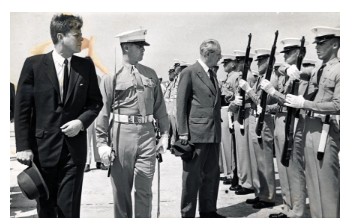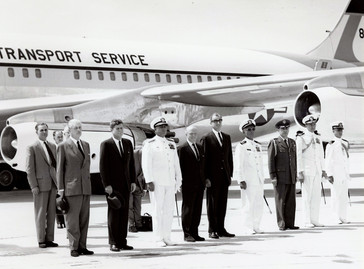How U.S. Presidents and the Military Defined Key West
- Nov 11
- 6 min read
While Key West champions "One Human Family" today, its historical motto might have been "One Military Family." The island's deep military connection, dating back to the Navy's 1820s establishment, has shaped its identity. During the Civil War, Key West, the sole Union city in Florida, strategically disrupted Confederate shipping. This vital role continued through two World Wars and Cold War aviation and submarine operations at Naval Air Station Key West.
Military service and sacrifice profoundly impacted Key West families and neighborhoods, fostering a palpable pride evident in its memorials. Bayview Park's Veterans Memorial Garden and the Vietnam Living Memorial honor those with local ties. The Vietnam memorial's committee meticulously verifies each name against official records. Annual ceremonies at Bayview Park, especially on Veterans Day, gather leaders, veterans, and families to commemorate service, ensuring this civic legacy and family honor endure.
The island's military significance began to materialize in the 1820s with the U.S. Navy's establishment of a strategic outpost designed to suppress piracy and safeguard vital maritime routes. The enduring legacy of this military presence is embodied by Naval Air Station Key West, inaugurated in 1917, a crucial operational hub whose designation honors its geographical setting and operational purpose rather than any particular person. In contrast, adjacent military installations and thoroughfares bear names that resonate with prominent historical figures and pivotal occurrences. Over time, Key West has consistently drawn presidential visits, serving as an ideal interlude for leaders en route to various Caribbean destinations.
Former U.S. President and Army General Ulysses S. Grant visited Key West. A parade was held on Duval Street, and he was the guest of honor at a dinner at the Russell House Hotel with silk menus printed in red, white and blue. 1880. (Source: Florida Keys History Center - Monroe County Public Library)
Ulysses S. Grant, the first U.S. President also a General, visited Key West in 1880, a significant post-presidency stop. Arriving eleven years after leaving office, aboard a steamship from New Orleans to Havana, the single-day visit highlighted Key West's military importance and post-Civil War national unity. Key West, now humorously dubbed "The Conch Republic" for its imagined secession, is Florida's only city loyal to the Union during the Civil War.
Historian Jefferson Browne noted the General's visit by calling it "a day memorable... all stores were closed and it was made a general holiday." The island hosted the Generals with a lavish dinner. A copy of the commemorative silk menu, printed in patriotic colors, survives at the Monroe County Public Library. Thee menu featured oysters, roasted turkey, beef tongue, ham, crawfish and crab salads, fruitcake, and vanilla ice cream.
Key West has hosted several notable figures, including former Confederate President Jefferson Davis, who visited in 1867 after his release. In 1889, Grover Cleveland received a public reception. President William Howard Taft arrived in 1912 via the Overseas Railway to inspect the Panama Canal.

Roosevelt Boulevard is one of Key West’s most prominent roadways, encircling much of the island’s waterfront and serving as a major artery for local traffic. Its name honors President Roosevelt and the impact of his policies on Key West. He visited the Florida Keys six times between 1917 and 1939, both as Assistant Secretary of the Navy and as President. His final visit in 1939 was particularly significant, as he rode in an open convertible down the newly constructed Overseas Highway. This symbolized the city's recovery from the Great Depression and the success of New Deal infrastructure projects. Roosevelt Boulevard was named in 1939, shortly after President Roosevelt’s visit and the completion of the Overseas Highway.

Key West had suffered severe economic decline during the Great Depression, with much of its population dependent on federal relief. The construction of the Overseas Highway, funded by New Deal programs, reconnected Key West to the mainland and opened new opportunities for tourism and commerce. Roosevelt’s visit in 1939 was a moment of celebration and renewal. The city organized a parade and other festivities to celebrate.
President Harry S. Truman’s relationship with Key West began in November 1946, when, exhausted by the burdens of office and a lingering cold, he was advised to recuperate at the Key West Naval Station. Truman’s first visit set a precedent for a series of working vacations—eleven during his presidency and five more after leaving office. He spent a total of 175 days on the island. During these stays, Truman conducted official business from the so-called “Little White House,” met with military and civilian leaders, and became a familiar and beloved figure in Key West.

Truman’s presence had a profound effect on Key West. His visits brought national attention to the city, boosted morale during the postwar years, and fostered a sense of pride in Key West. They wanted to honor him in a lasting and meaningful way, so the decision to rename Division Street as Truman Avenue was formalized on November 16, 1948.

This action was taken shortly after Truman’s unexpected re-election to the presidency and in recognition of his many visits and the positive impact he had on the city. The renaming was a tribute to Truman’s personal connection to Key West. It was also a reflection of the city’s gratitude for the national attention and federal support it had received during his administration.


Eisenhower Drive in Key West divides neighborhoods and links to main streets. Its name honors President Dwight D. Eisenhower's deep connection to the city. He recuperated at the Naval Station after a heart attack in late 1955. Before his presidency, Eisenhower, then Joint Chiefs Chairman, first visited Key West. He then returned as president from December, 1955 to January, 1956. President Truman, who had previously utilized the Little White House, suggested it to him. Eisenhower's visit attracted national media attention again for Key West; he held a press conference at the naval base, where he thanked the city for welcoming him.

Eisenhower's visits coincided with Key West's substantial expansion. The postwar era brought increased military facilities and federal investment. His presence underscored the island's strategic value and national recognition. Naming Eisenhower Drive immortalized Key West's presidential ties and its crucial place in American history.
Kennedy Drive, a street running north and south through Key West, winds its way through both neighborhoods and business districts. Its name is bound to the leadership of John F. Kennedy and the pivotal moments of the early 1960s. His visit to Key West in March 1961 was for a critical summit with British Prime Minister Harold Macmillan. The island's strategic significance was underscored by the Bay of Pigs debacle, precipitating Kennedy's return in November 1962, in the aftermath of the Cuban Missile Crisis.
Key West's streets, named after presidents like Truman, Kennedy, Eisenhower, and Roosevelt, are more than just addresses. They represent the island's significant place in American history. Many U.S. leaders, have visited Key West after leaving office. George H.W. Bush enjoyed fishing in nearby Islamorada. President Trump's visit was notable, because it was the first time a sitting president had been to Key West since Kennedy. It broke a 55-year gap.
Naval Air Station Key West is crucial for many military personnel. It's a major employer, shaping the island's population and economy. The base injects millions into the local economy annually, boosting real estate, businesses, and tourism. The island's military history is deeply embedded in its identity. You see it in facility names and historical events like General Grant's stays, the Cold War, and the Bay of Pigs invasion.
This strong military presence remains vital for Key West's economy and unique character, honoring a heritage of service and national importance. Every Veterans Day holiday is special in Key West, because of the unique history and military connections dating back to the 1800's.
Sources
Browne, Jefferson. Key West: The Old and the New, 1913.
wrote Jefferson Browne in his 1913 history book entitled Key West: The Old and the New.
“Honored Veterans.” Vietnam Living Memorial, https://vietnamlivingmemorial.com/honored-veterans/
“Keys Residents Remember President George HW Bush As Avid Sport Fisherman.” CBS Miami, 6 Dec. 2018, https://www.cbsnews.com/miami/news/keys-president-bush-avid-sport-fisherman/.
Klingener, Nancy. “Power Magnet: Key West's Long History Of Presidential Visits.” WLRN, 18 Apr. 2018. https://www.wlrn.org/news/2018-04-18/power-magnet-key-wests-long-history-of-presidential-visits.
“The President's News Conference at Key West, Florida.” The American Presidency Project, 8 Jan. 1956. https://www.presidency.ucsb.edu/documents/the-presidents-news-conference-key-west-florida.
“Today in Keys History – November 15.” Florida Keys History Center, Monroe County Public Library, 14 Nov. 2024. https://www.keyslibraries.org/post/today-in-keys-history-november-15.
“Veteran Profile.” Vietnam Living Memorial, https://vietnamlivingmemorial.com/vet-profile/profile3/

































Comments